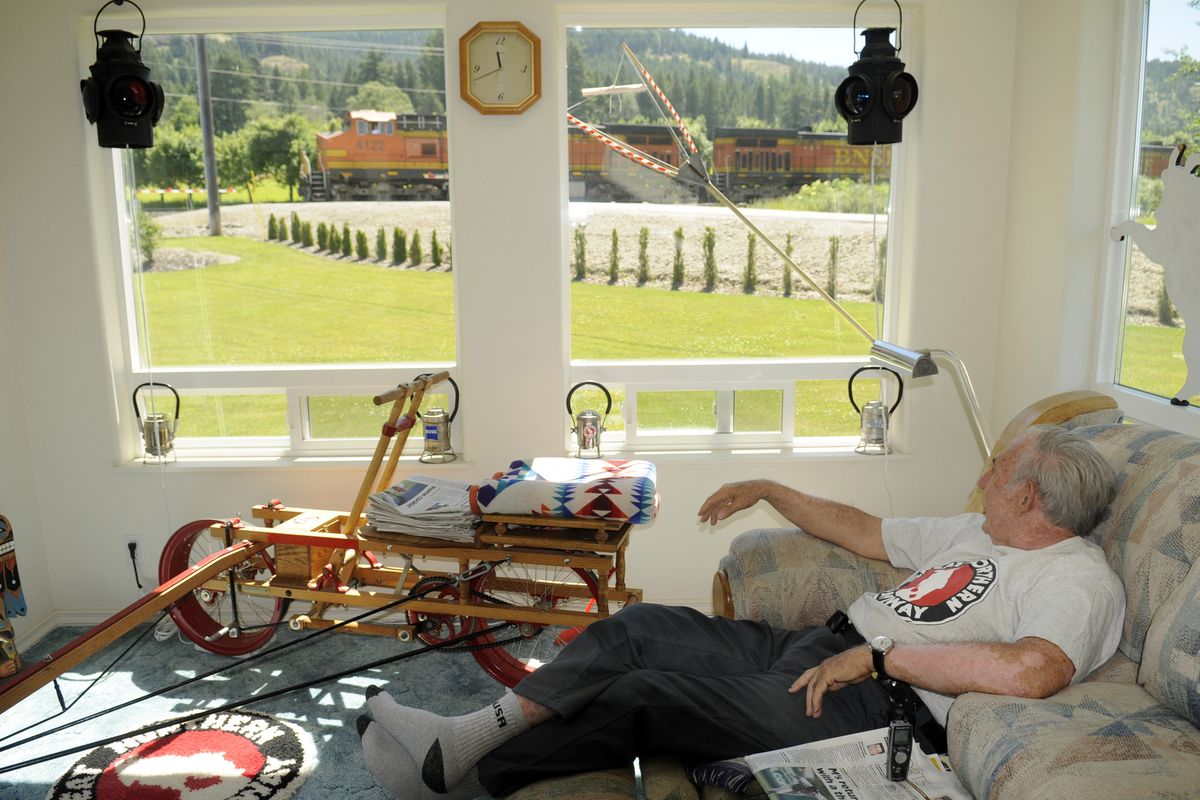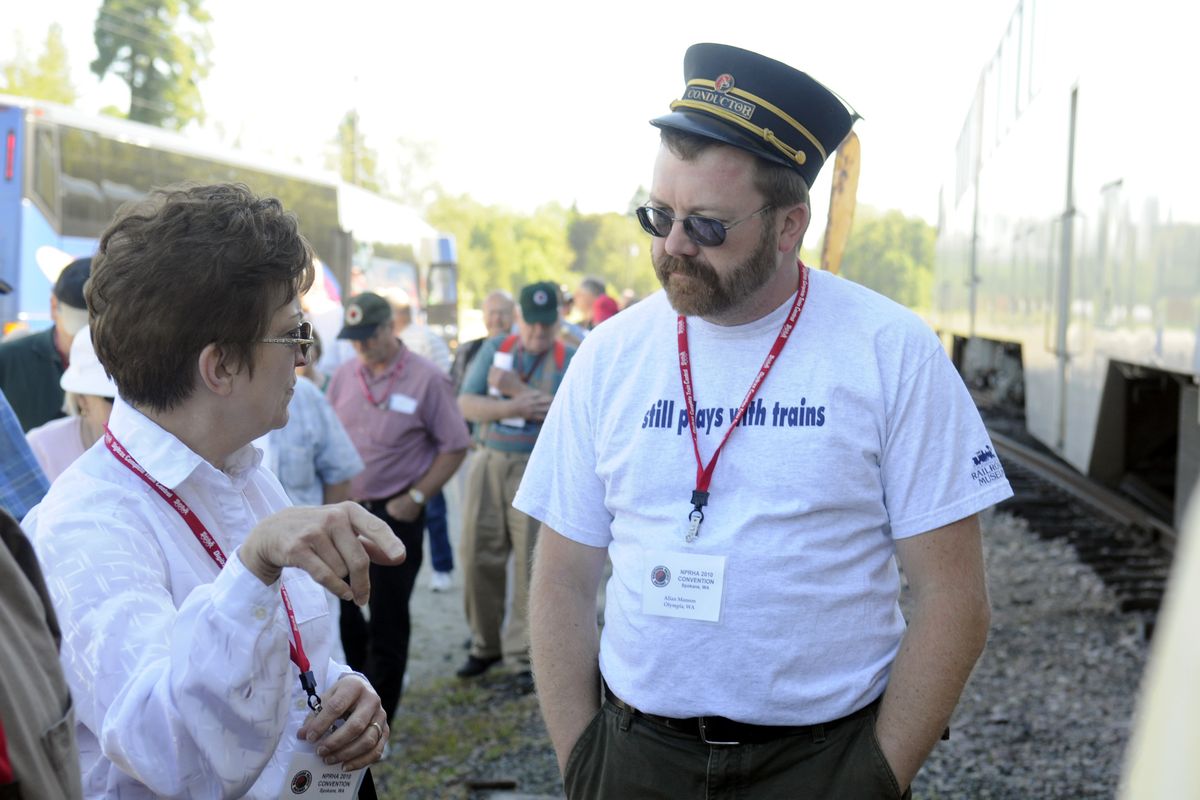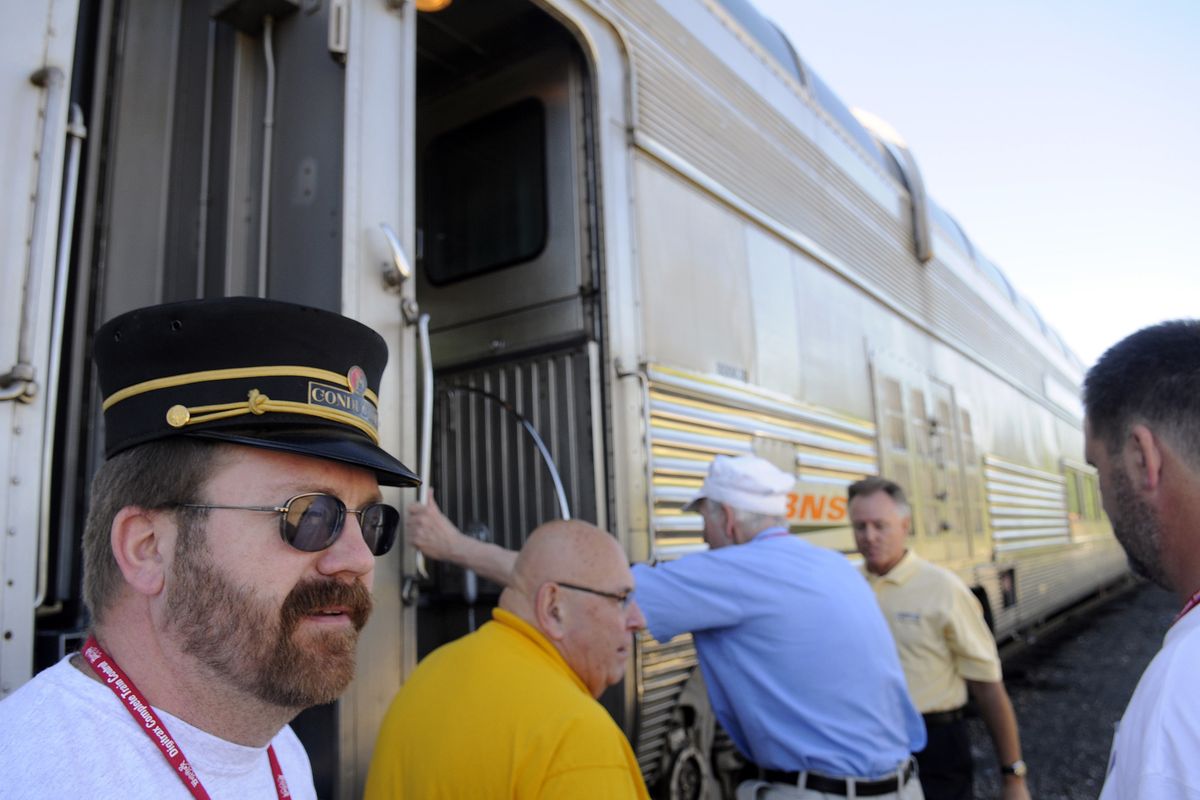All Aboard
‘Railfans’ from around the world flock to Sandpoint to admire and photograph passing trains
Allan Manson, right, wears a vintage conductor's cap as he welcomes riders on a special tour train Friday, July 16, 2010 near Sandpoint. Manson, a board member of the Northern Pacific Railway Historical Assocation, served a "car host" on the trip, talking with the passengers of the car he was assigned to ride for the trip to Paradise, Mont. and back. The riders were mostly those attending the NPRHA convention in Spokane. (Jesse Tinsley / The Spokesman-Review)
About 50 trains chug through Sandpoint each day, night and day.
Almost all carry cargo – grain, windmill turbines, airplane fuselages, even Barnum and Bailey circus elephants.
Near midnight, and then again at 2:32 a.m., Amtrak’s “Empire Builder” drops and collects passengers; Sandpoint boasts the only Amtrak stop in Idaho.
“Railfans” from throughout the world travel to Sandpoint to train-watch and photograph trains roaring across the bridge over Lake Pend Oreille. It’s a magnificent meeting of water, mountain and machine.
Sandpoint traces its vital beginning to the railroads, and the railroads might be one key to its economic future – especially if aging baby boomers journey there in great numbers in search of trains.
The beginning
Marianne Love, Sandpoint writer and sage, grew up on a farm close to the railroad tracks. In 1996, she wrote a definitive article on Sandpoint’s train history for Sandpoint Magazine.
“I don’t think we’d have a town if we didn’t have trains,” she said in a recent interview over breakfast at the Hoot Owl, a busy café popular with locals.
The Northern Pacific’s completion of its line in 1883 connected the fledgling town to the world beyond. In 1892, the Great Northern Railroad completed its line, too, bringing station agents L.D. and Ella Farmin to town.
“They ran the depot on the west side of Sandpoint,” Love said of the married couple. “Ella told stories of riding her pony through the woods to get to the railroad station. She kept a pistol due to the scary people along the way.”
L.D. laid out the town plat. The trains birthed the logging industry. Loggers moved to Sandpoint and grew their families there.
During the 1920s and 1930s, the dust bowl of the Midwest forced people westward.
“They would come on the trains with their cows and animals and families,” Love said. “That’s what started the agriculture of the area. So we had logging, agriculture and people working on the railroad.”
Despite the town’s railroad connections to the rest of the country, Sandpoint still had a wild West feel when Love’s mother arrived by train Christmas night, 1945, to join Love’s father, who was working a logging job in central Idaho.
“She arrived with my brother Mike,” Love said. “She had come from Chicago. She was six months pregnant with my brother Kevin.
“The train was loaded with soldiers coming home from the war. She always remembered how nice the soldiers were.
“She got off the train and it was an awful, wintry, wet night. She walked across the old Cedar Street Bridge, walked down to First Avenue, and it was filled with bars, with beer bottles flying out of the bars. She thought she had come to hell.”
In the 1950s, both passenger and cargo traffic boomed in Sandpoint.
“I always had this romantic thought of these trains and where they came from and where they were going,” Love said.
By the early 1970s, passenger trains were transportation’s gray ladies, replaced by “elegant” airplane travel. But cargo traffic has never ceased through Sandpoint, nor has residents’ love-hate relationship with trains.
Kathy Hubbard, board chairman of the Greater Sandpoint Chamber of Commerce, lives in East Hope near Sandpoint. She loves train whistles, but several years ago, a newcomer to her neighborhood did not.
The neighbor wrote the railroad, and according to Hubbard, “She said, ‘Can you please stop blowing the train whistle?’ They said, ‘Sure, but that means closing the road.’ ”
The whistles won.
The future
Four buses arrived near railroad tracks just outside Sandpoint at 8:30 a.m. one recent Friday, filled with 250 men and women attending the Northern Pacific Railway Historical Association annual convention held in Spokane this year.
They stepped off the buses and onto three passenger train cars out of the past, including a 1950s dome car. BNSF Railway owns the vintage cars and offered convention-goers a day ride to Paradise, Mont., in conjunction with Montana Rail Link.
Waiting to photograph the train were several Sandpoint-area railfans, including Aric Spence, who is leading an initiative to save the National Register of Historic Places train depot along Sand Creek. The station is locked down, rundown, in danger of a tear-down.
The Sand Creek Byway, a massive Sandpoint area highway project, squeezes the depot on one side. On the other side sits the upscale Seasons at Sandpoint condo resort, where the least expensive unit goes for $409,000.
“I am concerned about Sandpoint’s history getting lost,” said Spence. “The depot is the only gothic style depot in all of Idaho. It’s quite an asset for the town.”
The depot’s fate is uncertain, but Sandpoint will certainly continue to attract railfans because it’s a famous rail “funnel.”
What’s a funnel? Love explained: “The site where east-west railways in the northern states converge.”
The railfans boarding the vintage train cars wore shorts, T-shirts and tennis shoes, cameras slung about their necks. Most were in their 60s and 70s, but looked like eager kids headed to summer camp.
Gus Melonas, public affairs regional director for BNSF, greeted them with equal enthusiasm.
“This is railfan Mecca for America,” Melonas said of the Sandpoint area.
Dick Bosse lives in Mecca. The retired railroad worker built his dream home in 2002, just past Sandpoint’s long bridge in Sagle, because there’s a train crossing adjacent to his back yard. His sunroom and deck face the crossing.
Bosse chose Sandpoint over California for retirement because of its train culture.
In the mid-1990s, tourism officials touted Sandpoint as a railfan Mecca in national train magazine ads, but Sandpoint’s tourist and property boom eventually overshadowed its train appeal.
Then the property-tourism boom busted, and Sandpoint got derailed in California-Arizona-Las Vegas ways.
In a protracted transition from old economic engines to new ones, the town is figuring out its future.
“This year, watching the Fourth of July parade, it was disturbing to not to see one logging truck,” Love said. “Storage unit displays ferried though the parade seemed to replace them.”
Love and others would welcome more train promotion nationally, to attract railfans and folks such as Bosse who might retire in Sandpoint because of its train culture.
“Trains don’t make a big splash, but they are consistent,” she said.
Baby boomers – those born between 1946 and 1964 – will cause a cataclysmic spike in the country’s retirement population between 2010 and 2030, according to the federal Administration on Aging.
Jan Taylor, president of the Northern Pacific Railway Historical Association, said the median age of its members is 64, but the group is not dying; about 250 new members join each year.
Boomers don’t possess many firsthand memories of elegant passenger train travel, but they listened to the stories of their parents and grandparents. And interest in history perks up as people age.
Railfans need time and money, Taylor said, and it’s expected that many retired boomers will possess both.
In Sandpoint, you can watch trains power across the lake, day or night. You can buy houses with train crossings in the back yard.
You can, at least for now, visit a depot built in 1916. You can experience sights and sounds that transport you to a different reality.
“We like big powerful things,” Taylor said. “And so a great big locomotive, that’s interesting. And the sound? There’s a rhythm that’s pleasing to us.”







